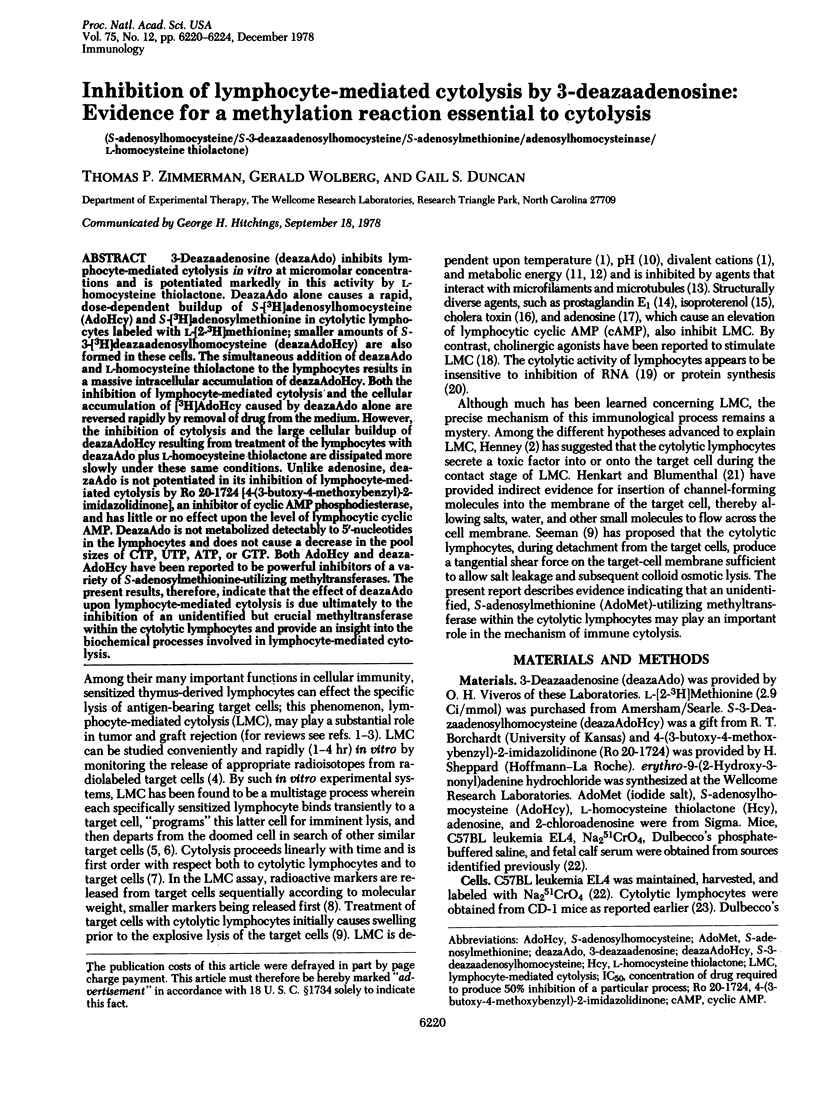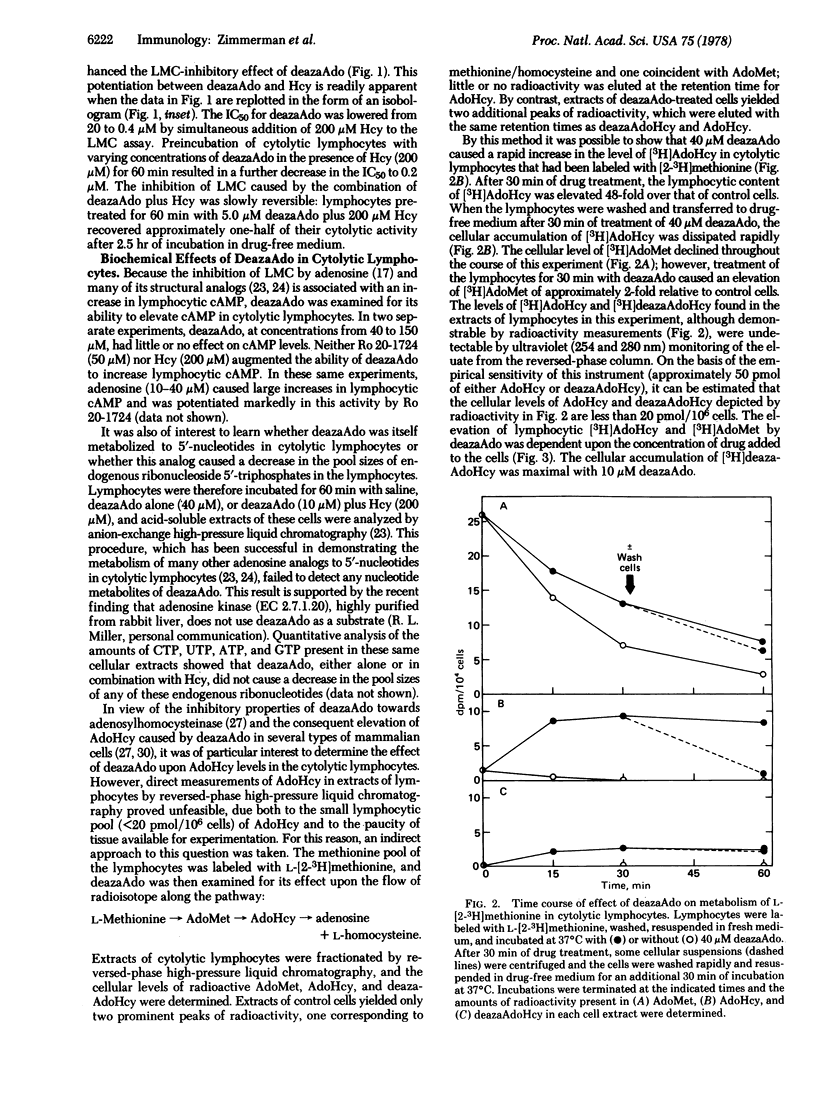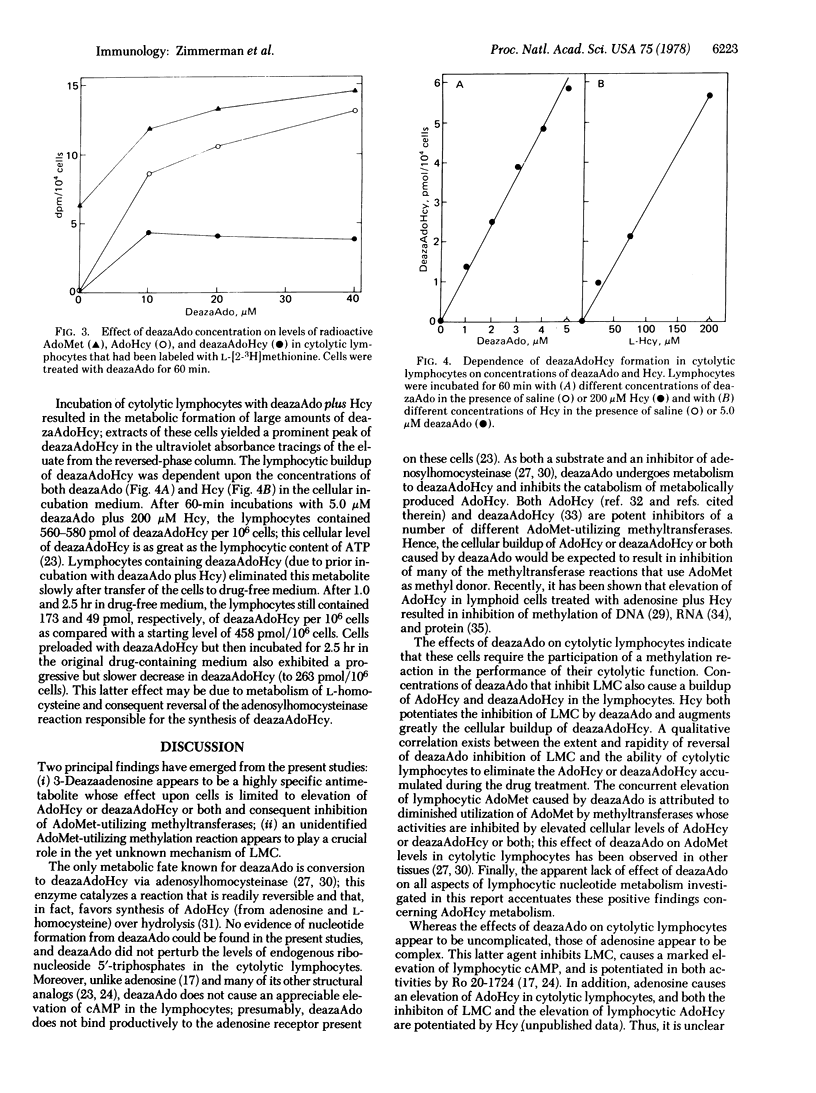Abstract
3-Deazaadenosine (deazaAdo) inhibits lymphocyte-mediated cytolysis in vitro at micromolar concentrations and is potentiated markedly in this activity by L-homocysteine thiolactone. DeazaAdo alone causes a rapid, dose-dependent buildup of S-[3H]adenosylhomocysteine (AdoHcy) and S-[3H]adenosylmethionine in cytolytic lymphocytes labeled with L-[2-3H]methionine; smaller amounts of S-3-[3H]deazaadenosylhomocysteine (deazaAdoHcy) are also formed in these cells. The simultaneous addition of deazaAdo and L-homocysteine thiolactone to the lymphocytes results in a massive intracellular accumulation of deazaAdoHcy. Both the inhibition of lymphocyte-mediated cytolysis and the cellular accumulation of [3H]AdoHcy caused by deazaAdo alone are reversed rapidly by removal of drug from the medium. However, the inhibition of cytolysis and the large cellular buildup of deazaAdoHcy resulting from treatment of the lymphocytes with deazaAdo plus L-homocysteine thiolactone are dissipated more slowly under these same conditions. Unlike adenosine, deazaAdo is not potentiated in its inhibition of lymphocyte-mediated cytolysis by Ro 20-1724 [4-(3-butoxy-4-methoxybenzyl)-2-imidazolidinone], an inhibitor of cyclic AMP phosphodiesterase, and has little or no effect upon the level of lymphocytic cyclic AMP. DeazaAdo is not metabolized detectably to 5′-nucleotides in the lymphocytes and does not cause a decrease in the pool sizes of CTP, UTP, ATP, or GTP. Both AdoHcy and deazaAdoHcy have been reported to be powerful inhibitors of a variety of S-adenosylmethionine-utilizing methyltransferases. The present results, therefore, indicate that the effect of deazaAdo upon lymphocyte-mediated cytolysis is due ultimately to the inhibition of an unidentified but crucial methyltransferase within the cytolytic lymphocytes and provide an insight into the biochemical processes involved in lymphocyte-mediated cytolysis.
Keywords: S-adenosylhomocysteine, S-3-deazaadenosylhomocysteine, S-adenosylmethionine, adenosylhomocysteinase, L-homocysteine thiolactone
Full text
PDF




Selected References
These references are in PubMed. This may not be the complete list of references from this article.
- Berke G., Amos D. B. Mechanism of lymphocyte-mediated cytolysis. The LMC cycle and its role in transplantation immunity. Transplant Rev. 1973;17(0):71–107. doi: 10.1111/j.1600-065x.1973.tb00124.x. [DOI] [PubMed] [Google Scholar]
- Berke G., Gabison D. Energy requirements of the binding and lytic steps of T lymphocyte-mediated cytolysis of leukemic cells in vitro. Eur J Immunol. 1975 Oct;5(10):671–675. doi: 10.1002/eji.1830051004. [DOI] [PubMed] [Google Scholar]
- Borchardt R. T. Inhibition of indolethylamine-N-methyltransferase by analogs of S-adenosylhomocysteine. Biochem Pharmacol. 1975 Aug 15;24(16):1542–1544. doi: 10.1016/0006-2952(75)90035-0. [DOI] [PubMed] [Google Scholar]
- Brunner K. T., Mauel J., Cerottini J. C., Chapuis B. Quantitative assay of the lytic action of immune lymphoid cells on 51-Cr-labelled allogeneic target cells in vitro; inhibition by isoantibody and by drugs. Immunology. 1968 Feb;14(2):181–196. [PMC free article] [PubMed] [Google Scholar]
- Cerottini J. C., Brunner K. T. Cell-mediated cytotoxicity, allograft rejection, and tumor immunity. Adv Immunol. 1974;18:67–132. doi: 10.1016/s0065-2776(08)60308-9. [DOI] [PubMed] [Google Scholar]
- Chiang P. K., Richards H. H., Cantoni G. L. S-Adenosyl-L-homocysteine hydrolase: analogues of S-adenosyl-L-homocysteine as potential inhibitors. Mol Pharmacol. 1977 Sep;13(5):939–947. [PubMed] [Google Scholar]
- DE LA HABA G., CANTONI G. L. The enzymatic synthesis of S-adenosyl-L-homocysteine from adenosine and homocysteine. J Biol Chem. 1959 Mar;234(3):603–608. [PubMed] [Google Scholar]
- Diliberto D. J., Jr, Veiveros O. H., Axelrod J. Subcellualr distribution of protein carboxymethylase and its endogenous substrates in the adrenal medulla: possible role in excitation-secretion coupling. Proc Natl Acad Sci U S A. 1976 Nov;73(11):4050–4054. doi: 10.1073/pnas.73.11.4050. [DOI] [PMC free article] [PubMed] [Google Scholar]
- Henkart P., Blumenthal R. Interaction of lymphocytes with lipid bilayer membranes: a model for lymphocyte-mediated lysis of target cells. Proc Natl Acad Sci U S A. 1975 Jul;72(7):2789–2793. doi: 10.1073/pnas.72.7.2789. [DOI] [PMC free article] [PubMed] [Google Scholar]
- Henney C. S., Lichtenstein L. M. The role of cyclic AMP in the cytolytic activity of lymphocytes. J Immunol. 1971 Aug;107(2):610–612. [PubMed] [Google Scholar]
- Henney C. S. On the mechanism of T-cell mediated cytolysis. Transplant Rev. 1973;17(0):37–70. doi: 10.1111/j.1600-065x.1973.tb00123.x. [DOI] [PubMed] [Google Scholar]
- Henney C. S. Studies on the mechanism of lymphocyte-mediated cytolysis. II. The use of various target cell markers to study cytolytic events. J Immunol. 1973 Jan;110(1):73–84. [PubMed] [Google Scholar]
- Holm G., Perlmann P. Quantitative studies on phytohaemagglutinin-induced cytotoxicity by human lymphocytes against homologous cells in tissue culture. Immunology. 1967 May;12(5):525–536. [PMC free article] [PubMed] [Google Scholar]
- Koren H. S., Ax W., Freund-Moelbert E. Morphological observations on the contact-induced lysis of target cells. Eur J Immunol. 1973 Jan;3(1):32–37. doi: 10.1002/eji.1830030108. [DOI] [PubMed] [Google Scholar]
- Kram R., Mamont P., Tomkins G. M. Pleiotypic control by adenosine 3':5'-cyclic monophosphate: a model for growth control in animal cells. Proc Natl Acad Sci U S A. 1973 May;70(5):1432–1436. doi: 10.1073/pnas.70.5.1432. [DOI] [PMC free article] [PubMed] [Google Scholar]
- Kredich N. M., Martin D. V., Jr Role of S-adenosylhomocysteine in adenosinemediated toxicity in cultured mouse T lymphoma cells. Cell. 1977 Dec;12(4):931–938. doi: 10.1016/0092-8674(77)90157-x. [DOI] [PubMed] [Google Scholar]
- Lichtenstein L. M., Henney C. S., Bourne H. R., Greenough W. B., 3rd Effects of cholera toxin on in vitro models of immediate and delayed hypersensitivity. Further evidence for the role of cyclic adenosine 3',5'-monophosphate. J Clin Invest. 1973 Mar;52(3):691–697. doi: 10.1172/JCI107230. [DOI] [PMC free article] [PubMed] [Google Scholar]
- Martz E. Early steps in specific tumor cell lysis by sensitized mouse T lymphocytes. I. Resolution and characterization. J Immunol. 1975 Jul;115(1):261–267. [PubMed] [Google Scholar]
- O'Dea R. F., Viveros O. H., Acheson A., Gorman C., Axelrod J. Protein carboxymethylase and methyl-acceptor proteins in human platelets and erythrocytes. Biochem Pharmacol. 1978 Mar 1;27(5):679–684. doi: 10.1016/0006-2952(78)90504-x. [DOI] [PubMed] [Google Scholar]
- O'Dea R. F., Viveros O. H., Axelrod J., Aswanikaumar S., Schiffmann E., Corcoran B. A. Raipid stimulation of protein carboxymethylation in leukocytes by a chemotatic peptide. Nature. 1978 Mar 30;272(5652):462–464. doi: 10.1038/272462a0. [DOI] [PubMed] [Google Scholar]
- Pike M. C., Kredich N. M., Snyderman R. Requirement of S-adenosyl-L-methionine-mediated methylation for human monocyte chemotaxis. Proc Natl Acad Sci U S A. 1978 Aug;75(8):3928–3932. doi: 10.1073/pnas.75.8.3928. [DOI] [PMC free article] [PubMed] [Google Scholar]
- Plaut M., Lichtenstein L. M., Henney C. S. Studies on the mechanism of lymphocyte-mediated cytolysis. 3. The role of microfilaments and microtubules. J Immunol. 1973 Mar;110(3):771–780. [PubMed] [Google Scholar]
- Schaeffer H. J., Schwender C. F. Enzyme inhibitors. 26. Bridging hydrophobic and hydrophilic regions on adenosine deaminase with some 9-(2-hydroxy-3-alkyl)adenines. J Med Chem. 1974 Jan;17(1):6–8. doi: 10.1021/jm00247a002. [DOI] [PubMed] [Google Scholar]
- Seeman P. Ultrastructure of membrane lesions in immune lysis, osmotic lysis and drug-induced lysis. Fed Proc. 1974 Oct;33(10):2116–2124. [PubMed] [Google Scholar]
- Sheppard H., Wiggan G. Analogues of 4-(3,4-dimethoxybenzyl)-2-imidazolidinone as potent inhibitors of rat erythrocyte adenosine cyclic 3',5'-phosphate phosphodiesterase. Mol Pharmacol. 1971 Jan;7(1):111–115. [PubMed] [Google Scholar]
- Strom T. B., Carpenter C. B., Jr, Cragoe E. J., Jr, Norris S., Devlin R., Perper R. J. Suppression of in vivo and in vitro alloimmunity by prostaglandins. Transplant Proc. 1977 Mar;9(1):1075–1079. [PubMed] [Google Scholar]
- Strom T. B., Garovoy M. R., Bear R. A., Gribik M., Carpenter C. B. A comparison of the effects of metabolic inhibitors upon direct and antibody-dependent lymphocyte mediated cytotoxicity. Cell Immunol. 1975 Dec;20(2):247–256. doi: 10.1016/0008-8749(75)90102-1. [DOI] [PubMed] [Google Scholar]
- Strom T. B., Sytkowski A. J., Carpenter C. B., Merrill J. P. Cholinergic augmentation of lymphocyte-mediated cytotoxicity. A study of the cholinergic receptor of cytotoxic T lymphocytes. Proc Natl Acad Sci U S A. 1974 Apr;71(4):1330–1333. doi: 10.1073/pnas.71.4.1330. [DOI] [PMC free article] [PubMed] [Google Scholar]
- Stulting R. D., Berke G. Nature of lymphocyte-tumor interaction. A general method for cellular immunoabsorption. J Exp Med. 1973 Apr 1;137(4):932–942. doi: 10.1084/jem.137.4.932. [DOI] [PMC free article] [PubMed] [Google Scholar]
- Thorn R. M., Henney C. S. Studies on the mechanism of lymphocyte-mediated cytolysis. VI. A reappraisal of the requirement for protein synthesis during T cell-mediated lysis. J Immunol. 1976 Jan;116(1):146–149. [PubMed] [Google Scholar]
- Wolberg G., Hümstra K., Burge J. J., Singler R. C. Reversible inhibition of lymphocyte mediated cytolysis by dimethyl sulfoxide (DMSO). J Immunol. 1973 Nov;111(5):1435–1443. [PubMed] [Google Scholar]
- Wolberg G., Zimmerman T. P., Duncan G. S., Singer K. H., Elion G. B. Inhibition of lymphocyte-mediated cytolysis by adenosine analogs. Biochemical studies concerning mechanism of action. Biochem Pharmacol. 1978 May 15;27(10):1487–1495. doi: 10.1016/0006-2952(78)90105-3. [DOI] [PubMed] [Google Scholar]
- Wolberg G., Zimmerman T. P., Hiemstra K., Winston M., Chu L. C. Adenosine inhibition of lymphocyte-mediated cytolysis: possible role of cyclic adenosine monophosphate. Science. 1975 Mar 14;187(4180):957–959. doi: 10.1126/science.167434. [DOI] [PubMed] [Google Scholar]
- Zimmerman T. P., Rideout J. L., Wolberg G., Duncan G. S., Elion G. B. 2-Fluoroadenosine 3':5'-monophosphate. A metabolite of 2-fluoroadenosine in mouse cytotoxic lymphocytes. J Biol Chem. 1976 Nov 10;251(21):6757–6766. [PubMed] [Google Scholar]


